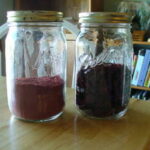The flavor of a home-grown plum beats grocery store plums hands down. Plums grown in your own backyard are much more juicy and flavorful than store bought plums because they are vine ripened. Grocery store plums are harvested before they are fully ripened in order to transport them easily without spoiling. The sweet goodness of home-grown plums doesn’t come without a price. Proper care for your plum tree is very important in growing sweet, delicious plums for eating, canning or freezing. This article will discuss all aspects of how to care for your plum tree.
Most plum trees will grow well in zones five through nine, so you need to make sure you live in a zone that will grow successful plum trees. Check out this website to find your zone: http://www.usna.usda.gov/Hardzone/ushzmap.html.
Soil Requirements
Plum trees will tolerate most types of soil, but prefer well-drained soil ranging in texture from a sandy loam to a sandy clay loam. The best thing to do is to take a soil sample to your local cooperative extension office for evaluation. They can tell you if your soil needs any amendments to grow successful plum trees.
Planting the Plum Tree
It’s a good idea to dig the hole for your plum tree about a month before actually planting the plum tree. Dig the hole about a foot deeper and wider than the roots on the tree. Your tree will thank you if you add some organic matter to the hole. When you’re ready to plant, add more loose soil to bring the top of the root of the plum tree up to ground level. Put the tree in the hole, add water and cover the roots with soil, packing it down. Do not add any fertilizer at this time. You may need to stake the tree until the plum tree gets established.
Fertilizer
Bone meal, fruit tree fertilizer spikes or a 10-10-10 fertilizer will make for a happy plum tree. Fertilize your plum tree in early spring and then again in August. Avoid using fertilizer near the trunk of the tree to prevent burning.
Mulching
Apply a good amount of mulch at least three feet around the plum tree trunk, avoiding the trunk itself. Mulching will help prevent weeds and retain valuable moisture. Keep down weeds surrounding the plum tree by spraying or mowing the grass. Doing so will cut down on insects.
Watering and Sun Requirements
The amount of water needed for a plum tree depends a lot on the weather. A hot summer day will make your plum tree need more water than a cool day. As long as you give your plum tree water during dry spells, you should be fine. Plum trees prefer full sun to flourish, although they can tolerate shade for a few hours a day.
Pruning
Pruning your plum tree is important to retain a good shape and to remove dead or diseased limbs. Here are some important things to know before you prune your plum tree. Never prune in winter, spring is the best time to prune your plum tree. Spring or summer pruning is best for older plum trees. Never prune your tree on a damp day, wait for a dryer day to prevent silver leaf disease. Silver leaf disease is a serious disease that enters the tissues of the tree through open cuts. Make sure cuts from a saw or clippers are clean cuts. You really should use a pruning paint on the limbs that have been pruned.
When pruning your plum tree, decide what type of formation you want. The most common way to prune your plum tree is to maintain an open center. Pruning to maintain a shape should be done in young trees, pruning as little as possible, just above a bud. Pruning in the early spring will allow the wounds to close faster as growth begins. Use thinning cuts to keep the center of the tree open and prevent limbs from breaking under the heavy weight of the fruit. Don’t let your plum tree branch too close to the ground. Pruning the top will help keep your plum tree low and more accessible.






